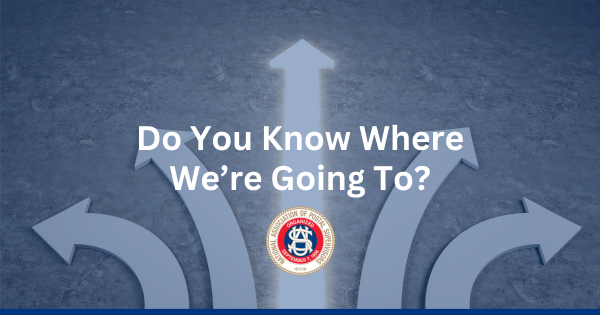Do You Know Where We're Going To?
Do You Know Where We’re Going To?
By Ivan D. Butts
NAPS National President
The song “Do You Know Where You’re Going To?”—famously performed by Diana Ross— carries a deeply reflective and introspective meaning. Written by Michael Masser and Gerry Goffin, the song originally was recorded by Thelma Houston, but became widely known through Ross’s 1975 version that was used as the theme for the movie “Mahogany.” At its core, the song is about looking back on one’s life, choices and dreams—and questioning whether the path taken has led to fulfillment or regret.
In this column, I would like to look back at the intended accomplishments of the “Delivering for America” (DFA) plan and what we are learning. The USPS introduced its DFA plan on March 23, 2021. Its aim was to transform America’s Postal Service into a self-sustaining and high-performing agency.
The plan’s core components include delivering 95% of all mail and shipping products on time, improving service performance and stabilizing the workforce. The plan also focused on reducing service goals to 90% for FY24 and 80% for FY25 to achieve break-even financial performance by FY28.
So, where are we with 95% on-time delivery of shipping products with today’s degraded service goals?
- In FY24, Quarter 3 (April–June), the USPS reported 95.3% of measured packages were delivered on time (within the service standard).
- Presort First-Class Mail, FY24, Quarter 4 (July–September)
—Overnight delivery: 93.7% on time
—Two-day delivery: 92.6% on time
—Three-to-five-day delivery: 90.9% on time
- Single-Piece First Class, Marketing Mail and Periodicals, FY24, Quarter 2, Jan. 1–19
—First-Class Mail: 84.0% delivered on time (-1.9 pp from Quarter 1)
—Marketing Mail: 92.1% on time (-1.6 pp)
—Periodicals: 80.6% on time (unchanged from Quarter 1)
As you can see, America’s Postal Service is struggling, despite severely reducing service goals. Some may remember this from a 2003 USPSNEWS@WORK article: “95% EXFC! USPS employees deliver record-breaking service performance.” This was not just 90% or 80 % of the time. (Source, USPS News, About USPS and postandparcel.info.)
How is America’s Postal Service doing in achieving the DFA’s projected financial benefits? While the USPS has made tangible progress, such as saving on transportation and consolidating operations, it has not yet met the financial goals projected in its DFA plan.
Despite some revenue gains, rising costs, service challenges and shortcomings in financial tracking have limited the Postal Service’s ability to break even or turn a profit. The DFA plan initially anticipated achieving positive net income by FY23. Instead, the USPS has posted substantial net losses—approximately $950 million in FY22 and $6.5 billion in FY23.
Although actual revenue exceeded forecasts, expenses outpaced gains due to inflation, higher-than-expected mail volume and limited progress on efficiency initiatives. Audit findings by the USPS OIG indicated the agency failed to link actual savings to specific DFA initiatives, making it impossible to assess performance against original plans.
The USPS achieved notable transportation cost reductions —$170 million in 2023 and $1.3 billion in 2024—while concerns increased over the use of freight brokers, as well as the associated reduction of safety and security.
The Postal Regulatory Commission (PRC) warned that many financial savings were “speculative” and “meager” relative to service downgrades, especially in rural areas. For instance, up to 40-50% of First-Class Mail might experience slower delivery. The USPS revised its service goals downward due to implementation challenges—FY24 targets fell to 90% and FY25 to 80%, down from a 95% goal.
Early communications suggest the USPS reduced projected 10-year losses from $160 billion to $70 billion and aimed to break even by plan’s end. However, auditors and analysts identified a cumulative negative variance of minus $1.5 billion on controllable financial results. The Lexington Institute noted that labor productivity fell 11% and total-factor productivity dropped 22% over three years.
The USPS is making strides, but has not yet realized the financial turn-around outlined in its DFA plan. Persistently large net losses, weak linkage between reforms and results, downgraded service targets and productivity declines paint a complex picture. While external reforms and ongoing efforts may help in future years, DFA has yet to deliver its anticipated financial dividends.
Through the end of FY23, the USPS spent approximately $6.7 billion of the planned $40 billion capital investment under DFA and committed around
$12.4 billion more for future expenditures. These costs accounted for unexpected overruns for various reasons.
In the first year, the USPS committed nearly $6.3 billion toward infrastructure improvements. This included delivery vehicles (specifically, the order for 50,000 Next Generation Delivery Vehicles at $3 billion), processing equipment, technology, facility upgrades and operations.
At the end of FY24, the USPS spent approximately $7.9 billion with 10 RPDCs and 115 SDCs completed. Projections put the remaining costs for completion of the DFA between $42.3 billion and $47.4 billion, depending on how progress is measured—not counting any further cost overruns.
This begs two questions. First, “From where are the remaining funds coming?” Could the agency’s massive RIFs and plant reclassifications that brought about executive and EAS downgrades just be a way of cutting costs at the expense of further service denigrations? The agency’s unwillingness to respond to NAPS’ multiple requests for quantification of the methodologies and matrices used for these changes suggests, possibly, “yes.”
The second question is, “Do we know where we’re going to?”
In solidarity …
